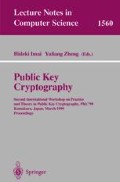Abstract
One of the key directions in complexity theory which has also filtered through to cryptographic research, is the effort to classify related but seemingly distinct notions. Separation or reduction arguments are the basic means for this classification.
Continuing this direction we identify a class of problems, called “matching problems,” which are related to the class of “decision problems.” In many cases, these classes are neither trivially equivalent nor distinct. Briefly, a “decision” problem consists of one instance and a supposedly related image of this instance; the problem is to decide whether the instance and the image indeed satisfy the given predicate. In a “matching” problem two such pairs of instances-images are given, and the problem is to “match” or “distinguish” which image corresponds to which instance. Clearly the decision problem is more difficult, since given a “decision” oracle one can simply test each of the two images to be matched against an instance and solve the matching problem. Here we show that the opposite direction also holds, presuming that randomization of the input is possible, and that the matching oracle is successful in all but a negligible part of its input set.
We first apply our techniques to show equivalence between the matching Diffie-Hellman and the decision Diffie-Hellman problems which were both applied recently quite extensively. This is a constructive step towards examining the strength of the Diffie-Hellman related problems. Then we show that in cryptosystems which can be uniformly randomized, non-semantic security implies that there is an oracle that decides whether a given plaintext corresponds to a given ciphertext. In the process we provide a new characteristic of encryption functions, which we call “universal malleability.”
Access this chapter
Tax calculation will be finalised at checkout
Purchases are for personal use only
Preview
Unable to display preview. Download preview PDF.
References
R. Canetti. Towards_realizing random oracles: Hash functions that hide all partial information. In B. Kaliski, editor, Advances in Cryptology — CRYPTO’ 97 Proceedings, LLNCS 1294), pages 455–469, Santa Barbara, CA, August 17–21 1997. Springer-Verlag.
A. Chan, Y. Frankel, and Y. Tsiounis. Easy come-easy go divisible cash. In Advances in Cryptology — Proceedings of Eurocrypt’ 98 (Lecture Notes in Computer Science 1403), pages 561–575, Helsinki, Finland, May 31–June 4 1998. Springer-Verlag. International patent pending. Available at http://www.ccs.neu.edu/home/yiannis/pubs.html.
R. Cramer and V. Shoup. A practical public key cryptosystem provably secure against adaptive chosen ciphertext attack. In Advances in Cryptology: Crypto’ 98, Proceedings (Lecture Notes in Computer Science 1462, pages 13–25, 1998. Available at http://www.cs.wisc.edu/shoup/papers/.
I. B. Damgård. Towards practical public key systems against chosen ciphertext attacks. In J. Feigenbaum, editor, Advances in Cryptology, Proc. of Crypto’ 91 (Lecture Notes in Computer Science 576), pages 445–456. Springer-Verlag, 1991.
O. Dolev, C. Dwork, and M. Naor. Non-malleable cryptography. In Proceedings of the 23rd Annual Symposium on Theory of Computing, 1991.
T. ElGamal. A public key cryptosystem and a signature scheme based on discrete logarithms. IEEE Trans. Inform. Theory, 31:469–472, 1985.
Y. Frankel, Y. Tsiounis, and M. Yung. Indirect discourse proofs: achieving fair off-line e-cash. In Advances in Cryptology, Proc. of Asiacrypt’ 96 (Lecture Notes in Computer Science 1163), pages 286–300, Kyongju, South Korea, November 3–7 1996. Springer-Verlag. International patent pending. Available at http://www.ccs.neu.edu/home/yiannis/pubs.html.
Y. Frankel, Y. Tsiounis, and M. Yung. Fair off-line cash made easy. In Advances in Cryptology, Proc. of Asiacrypt’ 98 (Lecture Notes in Computer Science). Springer-Verlag, October 18–22 1998. To appear. Available at http://www.ccs.neu.edu/home/yiannis/pubs.html.
S. Goldwasser and S. Micali. Probabilistic encryption. Journal of Computer and System Sciences, 28(2):270–299, April 1984.
O. Goldreich. A uniform-complexity treatment of encryption and zero-knowledge. Journal of Cryptology, 6(1):21–53, 1993.
D. Naccache and J. Stern. A new cryptosystem based on higher residues. In ACM CCS’ 98—Communications and Computer Security, 1998. To appear.
T. Okamoto. An efficient divisible electronic cash scheme. In Don Coppersmith, editor, Advances in Cryptology, Proc. of Crypto’ 95 (Lecture Notes in Computer Science 963), pages 438–451. Springer-Verlag, 1995.
T. Okamoto and S. Uchiyama. An efficient public-key cryptosystem. In Advances in Cryptology-Eurocrypt 98 proceedings (Lecture Notes in Computer Science 1403), pages 308–318, Espoo, Finland, 1998. Springer-Verlag.
Y. Tsiounis and M. Yung. On the security of El Gamal-based encryption. In International workshop on Public Key Cryptography (PKC’ 98) (Lecture Notes in Computer Science 1431), pages 117–134, Yokohama, Japan, February 5–6 1998. Springer-Verlag. Available at http://yiannis.home.ml.org.
Author information
Authors and Affiliations
Rights and permissions
Copyright information
© 1999 Springer-Verlag Berlin Heidelberg
About this paper
Cite this paper
Handschuh, H., Tsiounis, Y., Yung, M. (1999). Decision Oracles are Equivalent to Matching Oracles. In: Public Key Cryptography. PKC 1999. Lecture Notes in Computer Science, vol 1560. Springer, Berlin, Heidelberg. https://doi.org/10.1007/3-540-49162-7_22
Download citation
DOI: https://doi.org/10.1007/3-540-49162-7_22
Published:
Publisher Name: Springer, Berlin, Heidelberg
Print ISBN: 978-3-540-65644-9
Online ISBN: 978-3-540-49162-0
eBook Packages: Springer Book Archive

